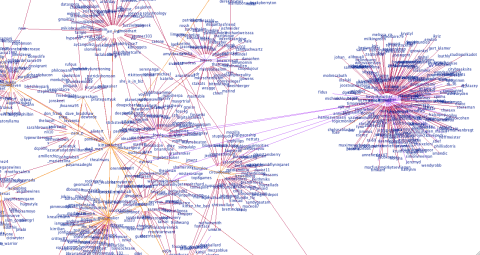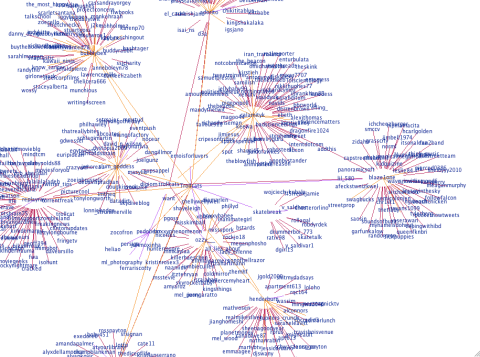I’ve frankly been amazed by the number of hits I’ve had on my Twitter Graphs since I put them up yesterday. This is the first phase of something I’m working on, so I’m going to write a little about the logic behind it here. Suggestions or thoughts are very welcome!
There was a time when follower counts meant something on Twitter. But that was probably before spammers, auto-follow (interesting article on how spammers and auto-follow have ruined the “social contract), and Robert Scoble‘s much hated “recommended list” (interesting post listing other people to follow who aren’t on the recommended list here). Now I think that looking at the number of people someone follows is a poor measure of their level of engagement with Twitter. Because I think a lot of what makes Twitter great is conversations it’s more interesting to me to measure those instead.
To clarify – the graphs I’ve done have mostly gone to a depth of 1, which means that it graphs the central user (checks their last 200 tweets for people they’ve mentioned, and the last 100 tweets that have mentioned them), and then does the same thing for everyone they’ve mentioned or who has mentioned them, but goes no further (I am aware of the flaws in this, fix coming soon). This means that there could well be (and likely are) connections between second degree nodes from the center person, which aren’t shown. The application doesn’t use verification, so people with protected tweets will seem to have only one way relationships because any mentions they’ve made will not show up.
Here’s my graph, below:

The yellow lines indicate a reciprocal relationship. Purple and red are one way relationships. It’s not always clear which direction it is in, but if you look at the “kittenthebad” node in the center, I mentioned “Zotero” (purple), but “unmasker” mentioned me (pink). If you look above to the left, you see my friends @zara_p and @douglasgresham and we have a little network going on there with a couple of other people we have in common. Below my node, you can see my friends @map_maker and @emdaniels and the people we have in common there too. So I think what my graph shows is that I’m primarily a conversationalist on Twitter and that most of the people I talk about, or to, I have a reciprocal relationship with. The other thing it shows, if you look at the number of people I’m following (57) is that the number of people I’m talking to is large relative to my network, about half.
Now let’s take the last person who auto-followed me based on a keyword (lolcats), (please don’t click on this link if you’re easily offended) Trollcats . As of writing this, Trollcats has 2,660 following and 5,367 followers so you’d expect them to have a huge graph, right? See below:

Their network here is much smaller, they’re having fewer conversations and the people who they’re having conversations with mostly aren’t connected to one another. This suggests that they’re less engaged, and are using Twitter as more of a broadcast medium. However if they were getting ReTweeted a lot, their graph would look different. Remember @snookca (his graph is here). He has around twice as many followers, but his graph is exponentially more crazy – because he’s engaged with Twitter and having conversations.
For a big broadcaster, see @guardiantech below – they’re not having a lot of conversations on Twitter but a lot of people are talking to or about them – likely they’re getting a lot more ReTweets:

So why is this useful, or interesting? This is fairly new, so I can’t be sure yet but here’s what I think we’ll find. I think that graphs will be different, depending on how people use Twitter. Conversationalists, spammers, the uber-popular will have distinct patterns. I think that visualizing your network will show you sub-networks that may be surprising, and get a measure of how many sub-networks you’re a part of (the next step of this is – what are these subnetworks talking about?), and will also show which of your friends are “Twitter Connectors” (people who are in a lot of sub-networks). And I think as a result of this, visualizing someone who’s followed you will tell you a lot about whether you want to follow them back. Are they a spammer? Are they just broadcasting? How engaged are they relative to the number of people they’re following – if very, they’re likely following you because they want to strike up a conversation. If not much, they may just be following you in the hope you follow them back.
This is written in Java and if you have some knowledge of programming and can run Eclipse it’s relatively easy to set up and run yourself. The source code is still being worked on, but I can make it available as-is to anyone who’s interested in running it.
25 replies on “Visualizing your Twitter Conversations: Rationale”
[…] Vizualising your Twitter Conversations: Rationale Visualizing Your […]
Definitely would love to play with this in Eclipse, thanks again for hooking me up with my own, I did a small article on it 🙂
http://circuitbomb.com/index.php/2009/10/awesome-twitter-conversation-graphs-whos-part-of-the-conversation/#more-98
Definitely would love to play with this in Eclipse, thanks again for hooking me up with my own, I did a small article on it 🙂
http://circuitbomb.com/index.php/2009/10/awesome-twitter-conversation-graphs-whos-part-of-the-conversation/#more-98
How familiar are you with Java? At the moment it’s only usable if you know what you’re doing because I’m still tweaking things. Hopefully by the end of the week I can have a Java application going which if you can install Java on your machine you should be able to run fairly easily.
Ooh node depth coloring is GO. But I’m over the API limit so I can’t get a screen shot for another 20 mins :'(
How familiar are you with Java? At the moment it’s only usable if you know what you’re doing because I’m still tweaking things. Hopefully by the end of the week I can have a Java application going which if you can install Java on your machine you should be able to run fairly easily.
Ooh node depth coloring is GO. But I’m over the API limit so I can’t get a screen shot for another 20 mins :'(
I’m no Java pro that’s for sure! But I am fairly proficient at running and compiling applications, I’ve used Eclipse in the past, run Aptanta for some web app dev-ing, and I’ve forged my way through Apache Nutch source code before. Already got latest Java SDK and Beans.
Its not a prob if you want to wait though, either way I’m totally interested in it, hehe
You could prob figure it out then, there’s just some project dependencies because I haven’t built prefuse. Have to finish my Combinatorial Algorithms assignment :'( then I can tidy it up for you and hopefully get my SVN set up so it’ll be easier to get updates! 🙂
You could prob figure it out then, there’s just some project dependencies because I haven’t built prefuse. Have to finish my Combinatorial Algorithms assignment :'( then I can tidy it up for you and hopefully get my SVN set up so it’ll be easier to get updates! 🙂
oh don’t be sad about your assignment, once its done its done :p At least its not a comprehensive user manual I have to have turned in, in a few weeks, bleh…I’m so tired of coms.
alright, I look forward to the SVN repo then, or if you want to get crazy and play with voodoo check out github.com or gitorious.com
keep me updated 🙂
[…] I think Haskell is most appropriate in this instance, for example, but I’m using Java for my visualizations. If I need to script something, I’ll probably use Python and I understand why C is still used […]
Hahaha it’s nearly done now. Visualizations are much more fun though! My friend was telling me about Git last night, he’s a big fan. I should look at it 🙂
Very cool, Cate. I think Twitter Lists might add some added depth to analyzing and visualizing the Twitterverse, but that is an extremely young feature right now. I’d love to see as you build out your Java app, as it might be very interesting to play around with. Thanks for the link re: social contracts 🙂
If you’d like to see how I think Twitter Lists might be used, I wrote a post here: http://viralogy.com/blog/social-media-tactics/how-twitter-lists-influence-influence/
Yeah it will be interesting to see if the list viz’s change as the feature evolves. I liked your post, what I’m looking at is mostly influence within the list though – which interestingly doesn’t correlate with followers/following so far, but I think it’s too early to tell.
Very cool, Cate. I think Twitter Lists might add some added depth to analyzing and visualizing the Twitterverse, but that is an extremely young feature right now. I’d love to see as you build out your Java app, as it might be very interesting to play around with. Thanks for the link re: social contracts 🙂
If you’d like to see how I think Twitter Lists might be used, I wrote a post here: http://viralogy.com/blog/social-media-tactics/how-twitter-lists-influence-influence/
Yeah it will be interesting to see if the list viz’s change as the feature evolves. I liked your post, what I’m looking at is mostly influence within the list though – which interestingly doesn’t correlate with followers/following so far, but I think it’s too early to tell.
[…] that long ago, I wrote about my Twitter Conversation Networks (read the rationale behind them) and I was blown away by the popularity and the amazing feedback that I got. So I tried to […]
[…] Visualizing Your Twitter Conversations: Rationale […]
Social comments and analytics for this post…
This post was mentioned on Twitter by sylc: Met @kittenthebad Talked about some of her work with Twitter visualizations. Check out her interesting post on this http://gets.to/OC3 #tto…
well to make the one-way relations more clear, you could have used “arrow heads” with the edges, i guess you are using prefuse thus this can be achieved easily,Â
and i would be much thankful if i can take a look at your code, since i’m also working on prefuse recently.
NorahIK
Hey Norah, source code is probably pretty out of date now, which bits were you wanting (or all?) I can try and hook you up, not sure if it will still work because they changed the developer API somewhat since.
is your code still available?
[WORDPRESS HASHCASH] The poster sent us ‘0 which is not a hashcash value.
I still have the code, although I don’t know that it will work given Twitter’s API changes. Send me an email telling me what you’re doing and wanting and I’ll see what I have?